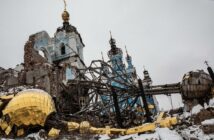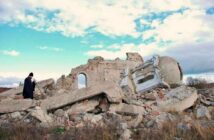Source: L’Agence France-Presse (AFP)Thomas Coex
Jerusalem — When you’re a journalist who works and lives in Jerusalem, you know that religious conflict is an important story. There’s so much tension here. You see it every day. We’re never far from a new conflict throughout the whole city.
Jerusalem is quite a unique place — it is the only place in the world that is holy to the three monotheistic religions — Judaism, Christianity and Islam.
When the city announced on a recent Sunday that they would start taxing the Church, all the church aides had a big press conference to say that they would close the church in protest. That was a big surprise for a lot of people. This is the holiest church in Christianity. It’s where Christians believe Jesus was buried, and where he rose again. They’re not usually so radical when they make decisions. And the fact that they were able to agree on anything at all is surprising.
They’ve only closed the church three other times, since Israelis captured the Old City during the war in 1967 — once in 1990 because a group of Jewish settlers built a settlement near the church for the first time since 1967; another time in 1999, because Muslims built a mosque near the Church of Annunciation in Nazareth; and in 2005, when they closed the church for a few hours after an act of vandalism inside. But this time, they closed it for three days. That’s the longest it’s been closed in 50 years.
There are two main reasons that the church aides decided to close the church — the money issue and the Status Quo issue.
The main problem is the Church’s relationship with the city of Jerusalem, and the pressure the mayor puts on it.
The municipality said that since the Church was making money, it had to pay taxes. The city said it was only seeking to tax what it classifies as Church-owned commercial property, and that places of worship and religious teaching would remain exempt. The Church has money, but it says it uses that budget to pay for Christian families to stay in Jerusalem. It’s kind of like a welfare system and for the Church, it’s very important, because the Christian population in Jerusalem has been dwindling and there are fears that it can disappear all together.
The cost of living in Jerusalem is very high, and poor families can’t rent an apartment without help from their community. So the church helps them, to keep up the Christian presence in the Old City.
Status Quo
Then there was the issue of the Status Quo, which dates from the Ottoman Empire, a few centuries before the state of Israel ever existed. It says that religious places don’t have to pay taxes — not just churches, but synagogues and mosques, too. The government and the municipality have to respect the Status Quo, and now all of a sudden they appeared to be trying to change it. The Church couldn’t see a solution, so the leaders decided to close it.
There’s something you need to understand about the church. There are six Christian groups who share the space: Coptic, Ethiopian, Syriac, Greek Orthodox, Franciscan, and Armenian. Only the Greek Orthodox, the Franciscans, and the Armenians take care of the Tomb of Jesus. The way they share the church is like what we French call co-propriétaire — co-ownership. They all have their own part of the church, and they can’t go into another sect’s part. There are a lot of rules, and it’s very strict.
If they want to change a lightbulb, for instance, they have to organize a meeting with all the groups just to say, “Ok, who will pay for the lightbulb? Who will change it?” So the fact that they all agreed to close the Holy Sepulchre is really rare.
But they forgot to send out a notice to worshippers, so only the journalists had the news. It was an amazing moment; even though all we could photograph was a closed door. There’s a secret door for friars to use in case of a fire, or a medical emergency. But officially there’s only the one door for worshippers, and it was closed.
We felt sorry for all these people who had traveled such a long way to see the Tomb of Jesus. I thought the church should have sent out a representative, or at least posted a sign explaining what was going on. During the three whole days we were there, people kept asking us, “Are you sure? Are you sure they won’t reopen the door?”
On a normal day, you get thousands of people arriving in busloads. But it’s a month before Easter, so you have even more people than normal. When you’re a tourist like this, you don’t read the news on your phone or listen to the radio in your hotel. So if your guide isn’t aware of the situation, you don’t know what’s happening.
Nobody knew how the negotiation was going. The journalists didn’t have any information from inside the church. There were a lot of rumors that it might reopen, so we stayed for the entire three days. We took shifts to make sure we covered everything, because you never know.
On Tuesday, a group of Christians organized a demonstration that ended at the Holy Sepulchre. There were all these people screaming and shouting, and all the tourists and worshippers really thought that the church would reopen after that. But it didn’t.
Then, on Tuesday evening the Israeli government announced that they would suspend the decision to tax the Church. I think they realized it could be a big problem for them, since so many tourists come to see the church. After that, everything seemed to go back to normal.
The Church is still negotiating with the mayor of Jerusalem, because the government only decided to suspend the decision, not repeal it. But on Wednesday, the church reopened at 4:00 am, just like always.
Same doorkeepers for 200 years
There’s a specific ritual for opening the door. The door is manned by a Muslim family, because the Status Quo said a neutral party had to man the door. It’s been the same Muslim family for 200 years.
The lock on the door is too high to reach without a stepladder, so the friars open a hatch in the door and pass a stepladder out to the two old Muslim men. They then use the stepladder to climb up to the lock and unlock the door.
There were maybe 50, 60 people waiting to go inside. That morning, the Armenian priests had organized the prayer service in the Tomb. Everyone went in and started praying on their knees. After about 15 minutes, more people started to arrive, but it wasn’t that crowded.
During a normal day, there are so many people at the church that you can spend one, one and a half hours in line just to spend 10 seconds in the Tomb. So 60 or even 80 people is nothing.
It’s not easy to find a good solution for everyone in this city. This place is a concentration of the origins of almost all the problems in the world. It’s the only place in the world with the three major monotheistic religions in the same place, in just a few hundred square meters.
I’ve been here for four years as the head of the photo department. I also worked here from 2000 to 2003, and I’ve been back a lot in between as a special envoy. For more than 2000 years, this place has been a place of conflict. But I’m going to miss it. In terms of food and culture, I definitely prefer Europe. But there are certain things here that are unlike anything else.
Like at Easter, when the Orthodox Christians have the Ceremony of the Holy Fire. Since there are so many rules, you have the Catholic Easter one week, and the Greek Orthodox Easter a week after that, and then the Coptic one a week later. And the Ethiopians have their Easter ceremony on top of the church. So for three straight weeks you have Easter. It’s the same at Christmas, but the Ceremony of the Holy Fire is absolutely amazing to see.
The ceremony doesn’t start until 2:30 in the afternoon, but you have to show up at 5:00 in the morning if you want to photograph it. It gets so crowded that you can’t move, and it’s hard to find a good place to shoot.
During the ceremony, everyone in the church circles the tomb something like eight times. Then the Greek Orthodox patriarch enters the tomb and comes out with a candle lit with the holy light, which he distributes to everyone.
It takes a while, because everyone waits with candles. And not just one candle, but whole packages of candles. But then everyone starts distributing the light to everyone else. The message is to go out of the church with the light, which represents Jesus’ life and resurrection, and spread it to other people.
This propagation of the light is amazing. I like to be up high and take pictures from the top, with the tomb in the center and everyone with their lit candles around it. You can feel the fervor building from the ground all the way up to the sky.
During the week before that you have Good Friday, and Passover, and the Friday prayer for Muslims, too. You see thousands of Muslims crossing the street to pray at the mosque, and Jewish people going to pray at the Western Wall.
Everybody has to survive together, and it’s not easy.
But when you walk through this city, you can feel something happened in history — History with a capital H. There are so many people who come from outside the city just to pray. There’s all this religious pressure here. I think even secular people feel it.
You can’t be indifferent when you work here.
This blog was written with Tori Otten in Paris.



